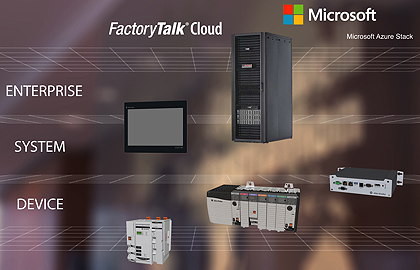- Home » News » Product News
Scalable computing offers IIoT data where decisions are made

Rockwell Automation has announced a series of scalable industrial computing offerings aimed at giving access to real-time data to solve analytical challenges, and to adapt to changes at every level of an organisation. It says that that this will help to improve productivity and efficiency in connected enterprises.
The offering covers three application levels: the device level; the system level; and the enterprise level.
At the device level, Rockwell has announced three product ranges designed to help operators make faster, more informed decisions close to the source of information. Each can run applications in a Windows 10 IoT Enterprise environment to gain better insight into machines and equipment. The choice of platforms gives users flexibility to suit individual applications. The three products are:
• An Allen-Bradley ControlLogix compute module that allows users to add Windows 10 IoT into Logix systems in existing applications and provides high-speed access to ControlLogix data via the backplane. It can combine Windows applications close to the point of decision-making.
• The Allen-Bradley CompactLogix 5480 controller, which combines Allen-Bradley Logix5000 control and Windows-based computing in a single controller. It supports Windows applications such as data collection, analytics and predictive computations, and is designed to meet the demands of high-performance production lines and information-driven smart machines.
• Rugged Allen-Bradley VersaView 5000 industrial computers, which provide visualisation and data aggregation for smart manufacturing. They have an open architecture, allowing users to install software specific to their applications. Rockwell Automation and partner applications can run directly on them. Users can visualise this data on a built-in or external monitor.
“Time is of the essence in industrial operations,” points out Greg Gernert, Rockwell’s global business manager, “so it’s critical that workers be able to consume data as close as possible to where it’s produced. These new device-level compute offerings provide real-time, close-to-the-source data access to help drive productivity in any industry.”

Rockwell Automation is building IIoT and analytics into these ranges. For example, the recently released FactoryTalk Analytics for Devices software can deliver real-time asset health and diagnostic information to the VersaView 5000 industrial computers.
At the system level, companies can use the system- and plant-level computing capabilities of Rockwell’s VersaView industrial computers. In addition, its Industrial Data Center (IDC) tracks productivity and downtime data, and offers predictive maintenance. The scalable, pre-engineered IDC system provides all of the hardware needed to run multiple operating systems and applications from virtualised servers. Rockwell can install, configure and manage the IDC as part of its Infrastructure-as-a-Service (IaaS) offering.
At the enterprise level, companies can use the IDC as an IaaS offering, or as a private, on-premises cloud platform. Rockwell can also provide its FactoryTalk Cloud – a public, remotely administered cloud platform powered by Windows Azure. The platform can help industrial companies to monitor remote assets, track historical data and analyse multi-site performance. It also can help OEMs to monitor and support machines after they have been installed at customers' sites.
“Azure provides a trusted and global-scale platform to develop and power advanced IoT solutions from the edge to the cloud,” says Sam George, director of Microsoft Azure IoT. “Rockwell Automation is taking full advantage of Microsoft’s comprehensive IoT platform, from integrating Windows 10 IoT Enterprise at the device level, to managing advanced data workloads at the edge and in the cloud with Azure IoT, to centralising operations monitoring and production performance across time zones. This results in better business outcomes and improved worker safety.”





